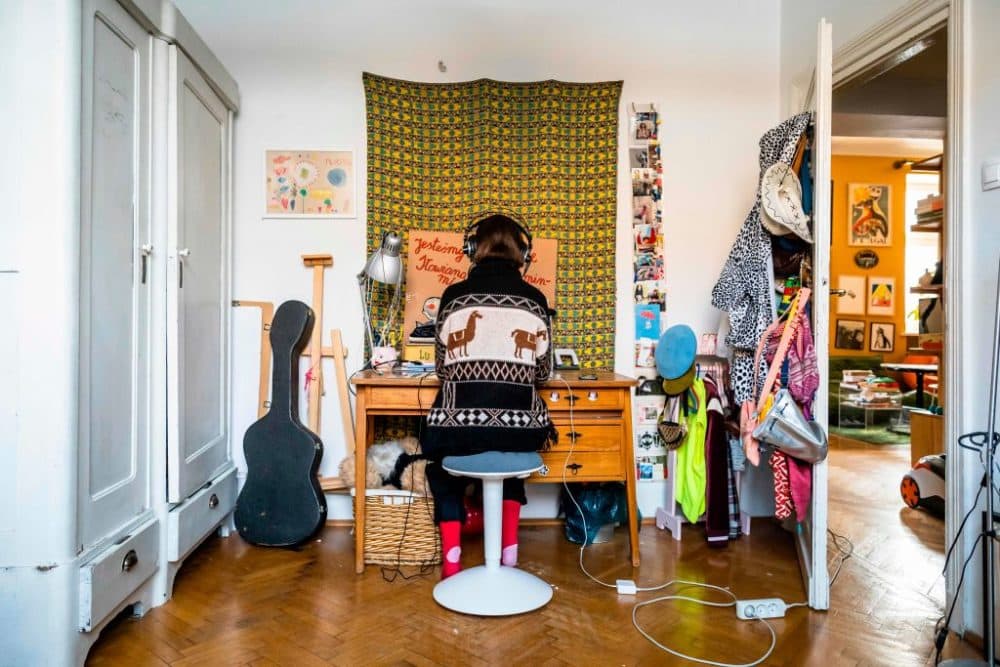Advertisement
Commentary
The Kids Are Not All Right
Resume
Like many families, we started lockdown with hope. My husband and I worked with our daughter on a quarantine schedule, a minute-by-minute plan balancing homework, outside time and recreation.
March morphed into May and the schedule was, long abandoned, a relic of a more innocent time. I was OK with this. But when it became clear that our teen wouldn’t graduate middle school or say goodbye to her classmates or teachers in person, I couldn’t help but feel sad. But she shut down any expression of grief. Don’t you see how lucky we are, she asked. Dad and you are working. No one we know died.
If she was disappointed or lonely she directed that energy into projects. During COVID summer she made band t-shirts, drawing logos and lyrics onto old sports and camp tees, fitting since all sports and camps were cancelled. She wallpapered her room in posters and pictures cut from magazines. She had one friend cleared for her “pod” and the two of them found escape through bottles of hair dye applied on weekend sleepovers. Our daughter went from bleached blonde and black, to David Bowie orange, to blue, which faded to a grey-green, which was dyed blue again — all changes documented and shared on social media.
At first, I bristled. Don’t you want to read a book, I said. What about spending time outside? But I considered my own teen years when I vociferously avoided home, working afterschool jobs, finding trouble with friends all over town. Getting away from your parents isn’t just a desire, it’s a developmental imperative. But the 15-year-old was effectively under house arrest. All of us were. She needed space to explore.
Was she doing ok? I wasn’t sure. I looked for clues in the titles of the many Spotify playlists she made alone in her room.
Was she doing ok? I wasn’t sure. I looked for clues in the titles of the many Spotify playlists she made alone in her room: Anxiety, Curing My Existential Dread, The Summer Inside, and one simply called Covid, featuring a cover of Brenda Lee’s “The End of the World.”
When we learned the teenager wouldn’t start high school in person, and that Zoom class would continue through the dark days of winter and into the indefinite future, the projects slowed, as did any excitement. She’d often wake only minutes before the beginning of her first class, logging in from her bed, camera off. I’d deliver her coffee and toast, trying to urge her into fresh clothes and a classroom space I’d set up in a spare room in the house. But my suggestions, whether delivered with gentle questioning or imposing authority, were met with indifference or hostility. When are you going to leave my room? Was the most common response.
Was this a sign of trouble or just lockdown with any 15-year-old? I imagine it’s hard to oversee an antsy elementary school kid, but at least they welcome your help.
Then late one night my husband and I awoke to the sight of her sitting at the end of our bed, her body racked with sobs. Can I tell you something? She began.
Despite a recent straight-A report card, she was behind in school work. She fell asleep in class. She didn’t know what to do. While spring semester was marked by forgiveness, kids were now expected to keep up the pre-pandemic load. And when she struggled, she didn’t blame home-schooling, or the isolation, or the extraordinary times we’re all still muddling through. She blamed herself.
I was hopeful when school went hybrid in March and then full-time in person this month. But the teenager remained nervous. Was it safe to return? We all received the district emails about another student having to isolate after testing positive for COVID-19. We also heard, later, about the senior at her high school who took her own life. And the many girls who are now cutting.
Returning to school posed health risks but so did staying home.
A recent national poll of parents conducted by University of Michigan’s C.S. Mott Children’s Hospital shows nearly half of respondents report their teen showing signs of a new or worsening mental health conditions since the start of the pandemic. And a report by the Centers for Disease Control and Prevention found that the proportion of 12- to 17-year-olds visiting emergency rooms for mental health reasons rose 31% for most of 2020 compared with 2019.
How will they metabolize the anxiety and ambient trauma of the last year?
At our daughter’s request, and after many emails followed by sorry, no new clients, we found someone she could talk to.
Today, my husband and I are both vaccinated. The teen has had her first shot. She’s even started playing lacrosse, taking advantage of the spring’s lengthening days to bike to the field and spend time with friends. Yet, while the CDC is no longer requiring masks, my daughter often prefers to wear hers, even outside, even when there’s no one around, even when it’s just the two of us in the car. She says it makes her feel more comfortable.
With the world starting to reopen, I’m eager to return to a semblance of our former lives, but I also wonder: what will be the long-term impact of the pandemic on these kids? How soon can they unlearn the hyper-vigilance we’ve drilled into them? How will they metabolize the anxiety and ambient trauma of the last year?
As parents, we are also changed. This is the year we learned to pick our battles. The year we learned to prioritize our kid’s mental health.
This segment aired on May 21, 2021.
